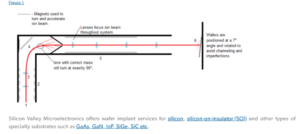During the wafer implant process, ions are accelerated in an electric field, generating a beam that is shot out at the wafer. This method is common because it allows for very precise dosing, which leads to more accurate location and depth of particles on the target wafer. Ion implantation is a low-temperature process.
The process begins with an ion source sending particles in a beam perpendicular to the target wafer (1). As the wafers leave the ion source, a series of magnets remove any excess particles that do not belong (2).
Once the particle beam leaves the ion source, lenses throughout the entire system ensure the beam stays focused on the target wafer (3).
After the ion beam leaves the source and goes through the first magnetic filtration, a process called mass separation uses another magnetic field to turn the particles exactly 90° (4). At this stage, particles are filtered out if their atomic weight does not exactly match that of the magnetic field. This filters out any impurities.
Next, the particles make their way to the acceleration lane (5). In the acceleration lane, anywhere from 10 to 500 keV (kiloelectron volts), depending on desired depth, the ion beams are accelerated to speeds high enough to implant the particles onto the target wafer. Depending on the application, speeds as low as 1 keV and as high as 5 meV (megaelectron volts) are used accelerate the particles in the ion beam. When at their max velocity, boron particles in an ion beam accelerated to 200 keV can be moving at speeds of up to 2,000,000 m/s.
After the beam makes contact with the wafer (6), only about 5% of ions bond due to the high velocity of the ion beam. The wafer is then annealed to solidify the bonds.

SVM’s Wafer Implant Capabilities:
- Diameters: 25mm to 300mm
- Low, medium, and high dose implant solutions.
- Implant energy range: 1KeV to 3,000KeV.
- Can provide implant on both bare and patterned wafer substrates.
- Can accept small volume prototype and large volume production quantities. (Implant is a small-batch process which tends to be pricier than other standard services)


